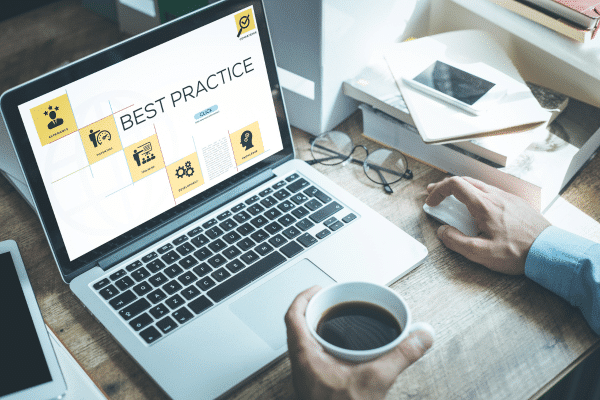- 619-846-5963
- Book A Discovery Call
- [email protected]
- 830 Kuhn Dr. Suite 210725, Chula Vista CA, 91921

Becoming an entrepreneur provides a unique and flexible experience that’s difficult to achieve through other career options. Many people are attracted to this path since it allows you to create your own schedule.
Unfortunately, approximately 45% of small businesses fail within the first five years. Poor website performance is often a major factor.
It’s crucial to focus on certain SEO benchmarks to achieve your desired business objectives. Let’s explore how to set actionable website goals and take your site’s performance to the next level.

This term refers to the number of people who find your site on their own. Having a high level of organic traffic is great for long-term performance.
To clarify, let’s assume you could only meet your traffic goals through paid ads. As soon as you stop budgeting for online ads, your traffic will drop. People who find your site organically are also already interested in what you offer.
Imagine your brand sells luxury men’s apparel. It’s possible to get your company in front of millions of people if you spend enough money on ads. This doesn’t mean those individuals will make a purchase, though.
If someone finds your website on a search engine, they’re likely looking for products like yours. Having great content on your site is one of the best ways to improve your organic traffic.
It’s not enough for people to see your ads online. They’ll need to take action and navigate to your website. Your click-through rate is the percentage of people who click on an ad to learn more.
This displays that your ad content is relevant and compelling. Maximizing click-through rates is essential for hitting target sales metrics.
It’s crucial to focus on your brand’s search engine results pages (SERP) visibility. This is the ratio of search volume to click-through rate.
The higher your SERP visibility, the better performance you can expect. Keep in mind that the difference between high rankings is much more significant than those of low rankings. A drop from position 1 to position 10 will hurt your brand much more than a drop from position 50 to position 60.
Many entrepreneurs make the mistake of targeting keywords they don’t rank well for. While it’s important to understand what your audience is searching for, you might not have enough of an online presence to leverage certain keywords.
A great example is the keyword “shoes.” Googling this comes up with numerous large companies that sell different types of footwear and apparel. It’s unlikely that the aforementioned luxury men’s apparel brand could compete with other businesses for this keyword.
Instead, you’ll need to focus on keywords that are less popular and more specific. A restaurant based in the city of Little Rock, Arkansas, could use a keyword like “Mexican cuisine Little Rock.”

The sites that link to yours are important to consider. No matter how many backlinks you have, it won’t do much for your SEO goals if they’re from low-quality sites.
In contrast, having backlinks from high-quality sites can substantially improve your SEO value. Many entrepreneurs use backlink monitoring tools to determine what sites direct traffic to theirs.
If a high-quality site links to yours, pay attention to the content they link to. You can then create more content like this in the future. If a low-quality site links to your content, you can contact them and ask to have the link removed.
This is a metric that search engines use to determine how reliable your website is. In general, websites that have been around longer will have higher domain authority.
Domain authority is also influenced by the websites that link to yours. As you might assume, backlinks from sites with a high domain authority will boost your rating more than sites with low domain authority.
The best way to improve your site’s authority is to be patient and emphasize other SEO strategies. It will slowly increase over time.
Your site’s bounce rate increases when people leave your site shortly after arriving. This shows search engines that your content is either irrelevant or low-quality. You can minimize your bounce rate by ensuring your content provides value to your audience.
If you notice a spike in your site’s bounce rate, you should investigate the cause. There’s a chance that a specific page is no longer loading correctly. The sooner you take action, the less likely you’ll encounter complications.
The longer people spend on your site, the better it is for your SEO value. Maximizing time spent on your site should be one of your most prominent website goals.
Your website should be easy to navigate and full of useful information. Long-form content is also great for keeping users around.
Similar to click-through rates, conversion rates are influenced by the number of people who take a specific action. A “conversion” could be virtually anything.
Some businesses might consider signing up for an email newsletter as a conversion. Another company might only consider sales as conversions.
Regardless of what variable you choose, keep track of this metric. Its change over time can reflect your company’s performance.
Never forget to assess your return on investment. Gross revenue won’t mean much if you spend tens of thousands of dollars generating sales. To calculate ROI, simply divide the profit you earned by how much money you invested.
For example, let’s assume a company made $10,000 from investing $1,000 into their SEO strategy. This would be a 1000% return on investment.
Reaching your SEO goals doesn’t have to be complicated. There are certain best practices you can implement to take your performance to the next level. Listed below are some of the most notable.

Competitive research is one of the most useful steps you can take. Look at their website and determine its strengths and weaknesses.
Is it easy to find the information you’re looking for? Do the pages load quickly?
How is your overall experience? After assessing their site, consider how you can use their strategies to help your own website.
Be careful not to make your site look too similar to a competitor’s. This could cause your audience to confuse you with your competition.
Learning from your past performance is crucial. This offers a look into strategies that work and those that don’t.
From here, you can reconfigure weak methods into something better. You can also emphasize the marketing tactics that already work.
It’s best to check your analytics monthly to stay updated on your performance. Some businesses check their analytics weekly or even daily.
The longer your page takes to load, the more likely your users are to leave. In fact, people often don’t stay on websites for more than a few seconds if the page doesn’t fully load.
If they end up on a competitor’s site afterward, it can be impossible to get them back. You can maximize load speed by optimizing your site’s images.
You can also utilize browser caching. This allows your site to store elements that won’t change often, making pages load quicker for users who frequently return to your site. For instance, a checkout page is unlikely to regularly change.
You could use browser caching to ensure a seamless checkout experience. Avoid using redirects on your site. These occur when one webpage forwards traffic to another.
Social media can be one of the most powerful tools when used correctly. It allows you to seamlessly interact with thousands of users.
They’ve already shown an interest in your brand since they follow your account. You can think of this as tapping into a list of warm leads.
Your social media content should direct users to your website. As long as you send them to pages they’re interested in, you can substantially boost your site’s SEO value. It could also lead to greater sales numbers since the page they reach will be relevant.
People love video content. They’re simply no other way to put it. Adding video to your SEO strategy can help bring people to your site and keep them there.
Posting on platforms like YouTube can also help build your social following. Remember to prioritize quality when creating video content. Ensure you use high-quality cameras and edit your videos professionally.
You should also pay attention to the lighting in your video content. It’s best to outsource this obligation if you don’t have the in-house personnel.

Using the right SEO benchmarks can dictate your company’s success. The tips on this list will ensure you get started on the right track and maximize your company’s performance.
At Ascendance Website Solutions, our team of experts has the knowledge and resources to unlock growth opportunities for your company. We can help you optimize your campaigns, track performance, and gain insight into better decision-making. Book a discovery call today to learn more about what we can do.

Ascendance is proud to offer a 10% discount for any business owner or entrepreneur who is current or former military or a first responder. This extends to family as well so if you have a family member that is current or former military or a first responder you will still receive the 10% discount for as long as you work with Ascendance!
Thank you all for your incredible service for our country and keeping us safe!